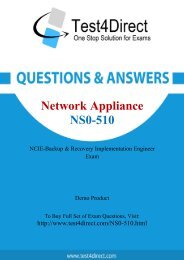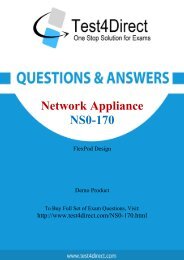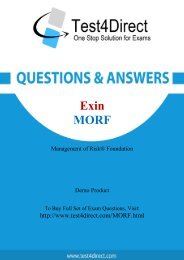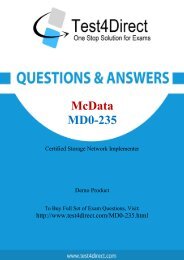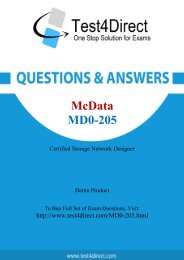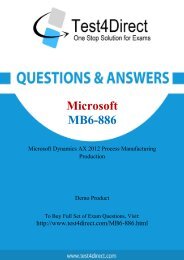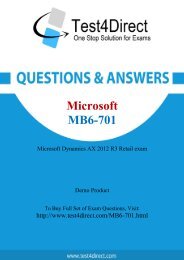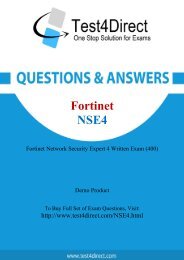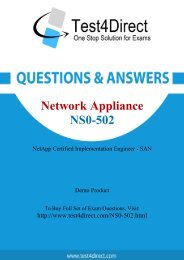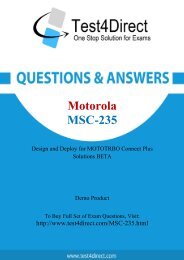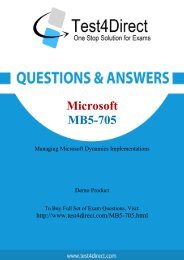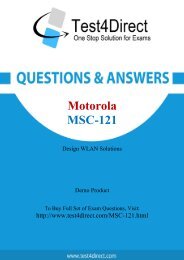Download MSC-131 BrainDumps to Success in career
Test4Direct provides latest PDF questions of Motorola MSC-131 exam. You have an opportunity to pass the Motorola MSC-131 exam in one go. Test4Direct is most accurate source to prepare Motorola MSC-131 exam as your success will become site’s responsibility after purchasing MSC-131 exam product. There are also lots of discounts and promotion offers that you can avail. Let’s try a free demo http://www.test4direct.com/MSC-131.html
Test4Direct provides latest PDF questions of Motorola MSC-131 exam. You have an opportunity to pass the Motorola MSC-131 exam in one go. Test4Direct is most accurate source to prepare Motorola MSC-131 exam as your success will become site’s responsibility after purchasing MSC-131 exam product. There are also lots of discounts and promotion offers that you can avail. Let’s try a free demo http://www.test4direct.com/MSC-131.html
Create successful ePaper yourself
Turn your PDF publications into a flip-book with our unique Google optimized e-Paper software.
Mo<strong>to</strong>rola<br />
<strong>MSC</strong>-<strong>131</strong><br />
Design and Deploy AirDefense Solutions<br />
Demo Product<br />
To Buy Full Set of Exam Questions, Visit:<br />
http://www.test4direct.com/<strong>MSC</strong>-<strong>131</strong>.html
Question: 1<br />
When would the configuration of ADSP <strong>in</strong>clude the use of a RADIUS server?<br />
A. When LDAP is not available<br />
B. When sensor validation is required<br />
C. When sensors require a VPN connection<br />
D. When centralized authentication is required<br />
Answer: D<br />
Question: 2<br />
What is the purpose of the Bond<strong>in</strong>g command <strong>in</strong> the ADSP CLI?<br />
A. The Bond<strong>in</strong>g command is used <strong>to</strong> l<strong>in</strong>k sensors <strong>to</strong> the correct conta<strong>in</strong>er <strong>in</strong> the ADSP tree.<br />
B. The Bond<strong>in</strong>g command is used <strong>to</strong> enable the Primary and Secondary ADSP appliances <strong>to</strong><br />
synchronize.<br />
C. The Bond<strong>in</strong>g command is used <strong>to</strong> enable both of the NIC's on ADSP's system board <strong>to</strong> act as one<br />
for high availability.<br />
D. The Bond<strong>in</strong>g command is used <strong>to</strong> ensure that both the Primary and Secondary ADSP appliances<br />
are configured <strong>to</strong> use the same IP address.<br />
Question: 3<br />
What security exists for the communication between sensors and the ADSP appliance?<br />
A. EAP-TTLS and SSL<br />
B. PEAP and SSL<br />
C. PKI and SSL<br />
D. EAP-TLS and SSL<br />
Question: 4<br />
Answer: C<br />
Answer: C<br />
Spectrum Analysis can be performed us<strong>in</strong>g different modes of operation. Which of follow<strong>in</strong>g modes<br />
would be the most appropriate <strong>to</strong> use if you need <strong>to</strong> perform a Spectrum Analysis and capture<br />
<strong>in</strong>formation about the data l<strong>in</strong>k layer (Layer 2 of OSI model)?<br />
A. Dual Layer Scan Mode<br />
B. Cont<strong>in</strong>uous Scan Mode<br />
C. Background Scan Mode<br />
D. Interference Scan Mode
Answer: C<br />
Question: 5<br />
Broadcast<strong>in</strong>g the SSID and allow<strong>in</strong>g the access po<strong>in</strong>t <strong>to</strong> respond <strong>to</strong> clients with no SSID makes it<br />
easier for the clients, but some consider it a security loophole. The theory for disallow<strong>in</strong>g these two<br />
practices is that it helps “hide” the network. What is the problem with this theory?<br />
A. Hid<strong>in</strong>g the SSID turns off the beacons thus disabl<strong>in</strong>g passive scann<strong>in</strong>g<br />
B. Not respond<strong>in</strong>g <strong>to</strong> null SSIDs causes the EAP process <strong>to</strong> break down<br />
C. These values must be present <strong>in</strong> order for <strong>in</strong>trusion detection systems <strong>to</strong> function<br />
D. The SSID will still be present <strong>in</strong> probe request frames and can be seen with a pro<strong>to</strong>col analyzer<br />
Question: 6<br />
Question: 7<br />
Question: 8<br />
Answer: D<br />
You have configured your ADSP appliance <strong>to</strong> use a RADIUS server <strong>to</strong> validate user credentials upon<br />
GUI logon. However, users cont<strong>in</strong>ue <strong>to</strong> be validated directly by ADSP. What additional step must be<br />
taken <strong>to</strong> ensure GUI users are authenticated via the RADIUS server you configured when they are<br />
logg<strong>in</strong>g <strong>in</strong><strong>to</strong> ADSP?<br />
A. The ADSP appliance must be rebooted <strong>to</strong> ensure the sett<strong>in</strong>gs are recorded properly<br />
B. Each user account must be configured <strong>to</strong> use the correct RADIUS server for authentication<br />
C. You must log <strong>in</strong><strong>to</strong> the CLI us<strong>in</strong>g the SMXMGR account and run the Enforce Credentials command<br />
D. Log <strong>in</strong><strong>to</strong> the GUI with your adm<strong>in</strong> account and click on the Synchronize RADIUS Accounts but<strong>to</strong>n <strong>in</strong><br />
Appliance Manager<br />
Answer: B<br />
A requirement for seamless roam<strong>in</strong>g <strong>in</strong> a Robust Security network is that the access po<strong>in</strong>ts receive<br />
the Pairwise Master Key (PMK) identifier from the station <strong>in</strong> the reassociation frame. What other<br />
<strong>in</strong>formation must be <strong>in</strong>cluded <strong>in</strong> that frame?<br />
A. Any 802.1g VLAN tags.<br />
B. The IP address and subnet mask.<br />
C. The randomly generated shared secret.<br />
D. The MAC address of the old access po<strong>in</strong>t.<br />
Which of the follow<strong>in</strong>g appropriately characterizes a rogue access po<strong>in</strong>t (AP)?<br />
A. An AP that is caus<strong>in</strong>g Co-Channel <strong>in</strong>terference with your APs.<br />
Answer: D
B. An AP that is not the same brand as your cus<strong>to</strong>mers APs.<br />
C. An AP that is on your wired network without proper authorization.<br />
D. An AP that is not us<strong>in</strong>g the security required by corporate policy.<br />
Answer: C<br />
Question: 9<br />
A new coffee shop opens <strong>in</strong> your build<strong>in</strong>g offer<strong>in</strong>g hotspot <strong>in</strong>ternet access. Several of your users are<br />
connect<strong>in</strong>g <strong>to</strong> the hotspot while at their desks <strong>to</strong> bypass your firewall rules. What is the best th<strong>in</strong>g<br />
that can be done us<strong>in</strong>g the ADSP system <strong>to</strong> prevent this?<br />
A. Integrate with the firewall us<strong>in</strong>g SNMP and import the same firewall rules.<br />
B. Create a term<strong>in</strong>ation policy <strong>to</strong> prevent accidental associations of authorized AP's.<br />
C. Create a term<strong>in</strong>ation policy <strong>to</strong> prevent authorized stations from us<strong>in</strong>g ad-hoc networks.<br />
D. Create a term<strong>in</strong>ation policy <strong>to</strong> prevent accidental associations of your work stations <strong>to</strong><br />
unauthorized networks.<br />
Question: 10<br />
Answer: D<br />
There was a rogue AP on your network as detected by ADSP. The rogue was displayed <strong>in</strong> your Alarms.<br />
When you run a wireless security posture details report for the same time range, the rogue does not<br />
appear <strong>in</strong> the report. What is the most likely cause for the rogue not be<strong>in</strong>g <strong>in</strong> the report?<br />
A. The report was run for a different scope than the one that detected the rogue.<br />
B. Your account was not created <strong>in</strong> the scope level where the rogue was detected.<br />
C. You are logged <strong>in</strong><strong>to</strong> ADSP as a guest account which lacks the permission <strong>to</strong> run the report.<br />
D. The rogue device has been removed from the network and the correspond<strong>in</strong>g alarm is now<br />
<strong>in</strong>active.<br />
Answer: A
THANKS FOR TRYING THE DEMO OF OUR PRODUCT<br />
Visit Our Site <strong>to</strong> Purchase the Full Set of Actual <strong>MSC</strong>-<strong>131</strong> Exam Questions With Answers.<br />
http://www.test4direct.com/<strong>MSC</strong>-<strong>131</strong>.html<br />
We Also Provide Practice Exam Software That Simulates Real Exam Environment And Has<br />
Many Self-Assessment Features. <strong>Download</strong> Free Product Demo From:<br />
http://www.test4direct.com/<strong>MSC</strong>-<strong>131</strong>.html<br />
Money Back Guarantee<br />
Check Out Our Cus<strong>to</strong>mer Testimonials



